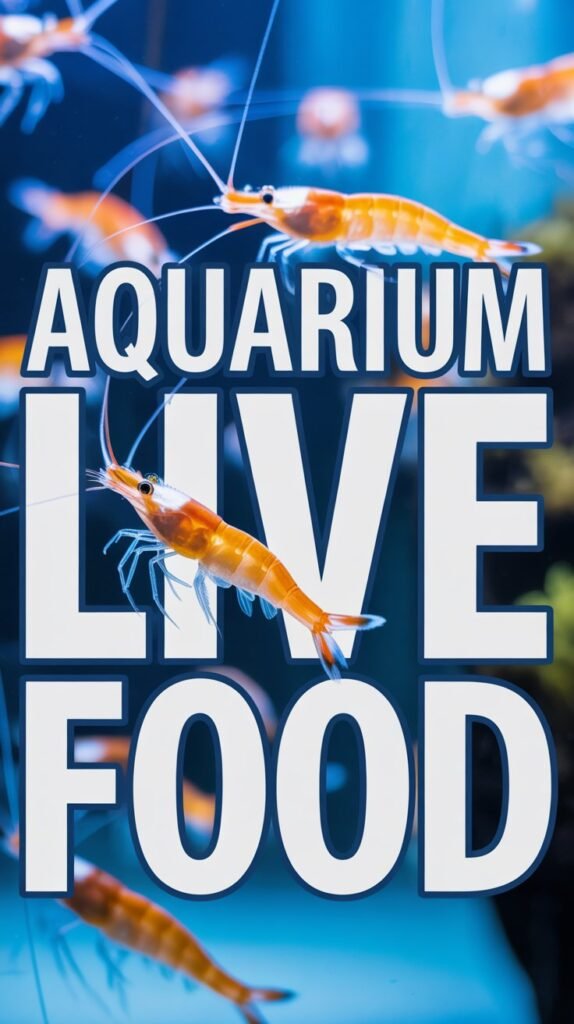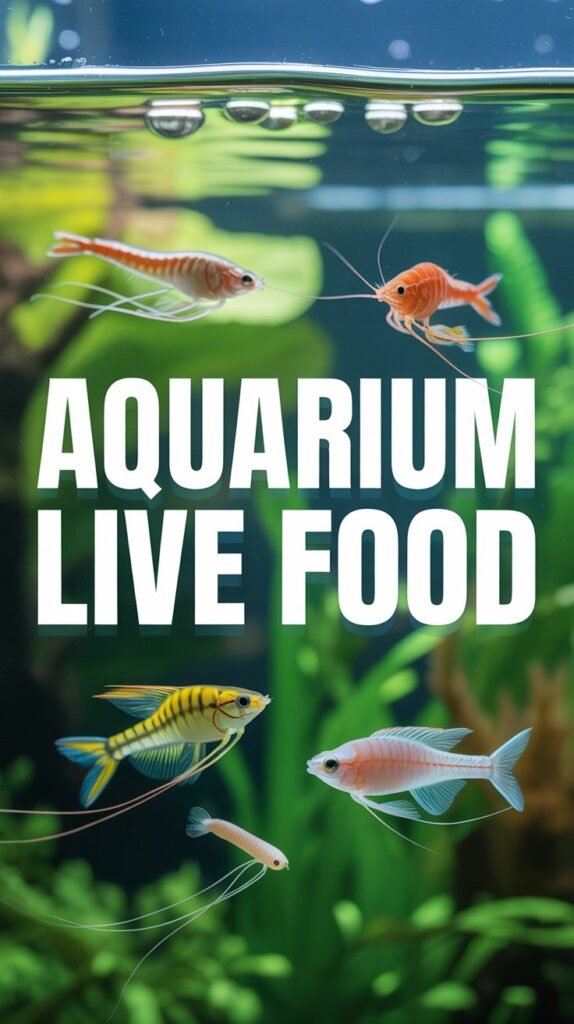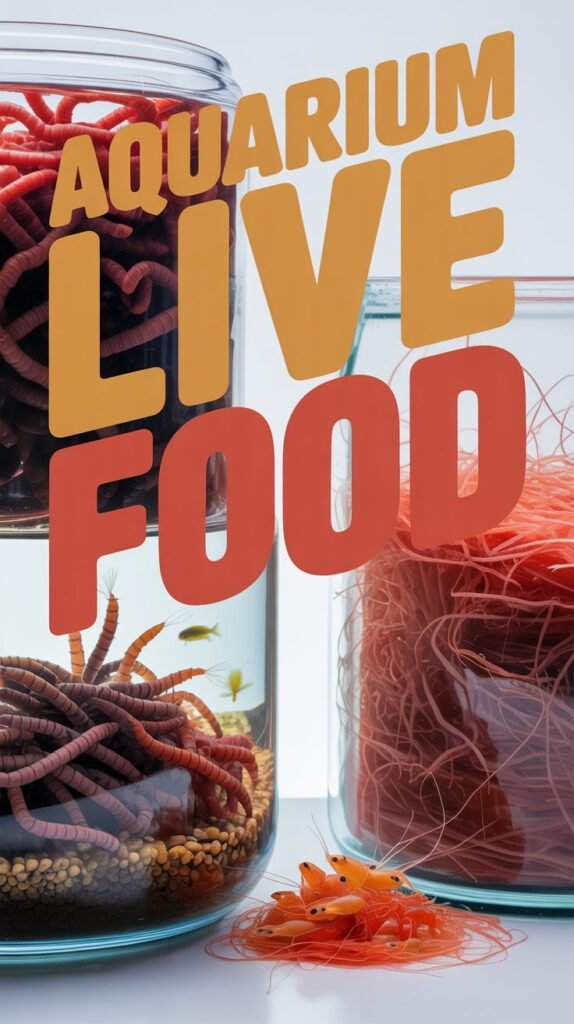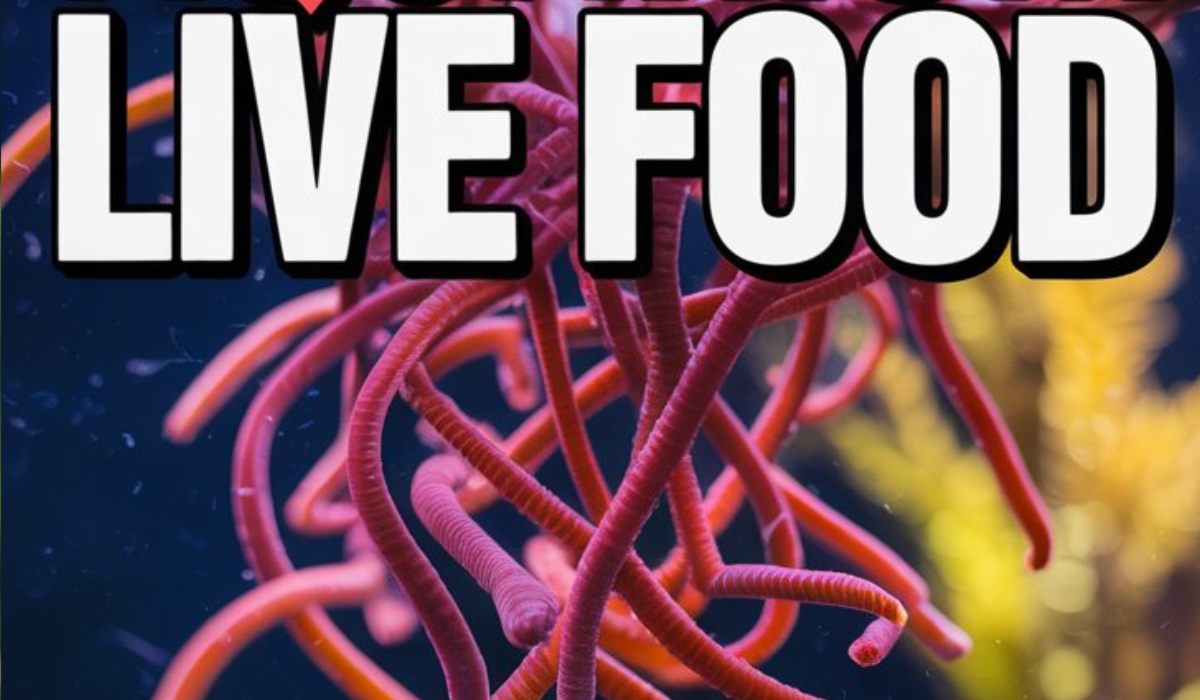Feeding your aquarium fish the right diet is one of the most important aspects of maintaining a healthy and vibrant aquarium. While commercial fish flakes and pellets are convenient, nothing compares to the nutritional value and natural behavior stimulation provided by live food. Aquarium live food not only enhances fish coloration and immunity but also encourages natural hunting instincts, making your aquarium ecosystem more active and dynamic.
Whether you’re an aquarist keeping guppies, cichlids, bettas, or marine species, understanding the role of live food is essential. This comprehensive guide will explore everything about aquarium live food — its types, nutritional benefits, how to culture it, feeding tips, and safety measures — to help you raise healthier, more energetic fish.
What Is Aquarium Live Food?
Aquarium live food refers to living organisms used as fish feed. These include worms, crustaceans, insects, larvae, and even smaller fish. Unlike processed foods, live foods provide natural proteins, fats, and vitamins that mimic a fish’s diet in the wild.
In the natural environment, most fish feed on small aquatic creatures such as plankton, insect larvae, or tiny crustaceans. By introducing live food into your aquarium, you replicate this diet, improving fish health and promoting their natural feeding behavior.
Live food can be used for:
- Daily feeding for predatory fish
- Conditioning fish for breeding
- Enhancing coloration and growth
- Feeding fry (baby fish) with easily digestible proteins
Benefits of Feeding Aquarium Live Food

Feeding live food to your aquarium fish provides a wide range of benefits that processed food alone cannot achieve.
1. Superior Nutrition
Live food is rich in proteins, amino acids, and healthy fats, making it ideal for rapid growth and energy. It also contains essential nutrients that enhance immunity and reproduction.
2. Stimulates Natural Behavior
Hunting and chasing live prey keeps fish active and reduces boredom. This stimulation helps in maintaining natural instincts, especially in carnivorous and omnivorous species.
3. Enhances Coloration
Nutrient-rich live foods such as brine shrimp and daphnia contain carotenoids and essential fatty acids that boost the vibrant colors of ornamental fish.
4. Ideal for Breeding
Live food is a powerful breeding conditioner. It triggers spawning behavior in many species by mimicking the seasonal abundance of prey in the wild.
5. Improves Digestion
Unlike some dry foods, live foods are easily digestible. They promote a healthy gut and reduce the risk of bloating and constipation.
6. Perfect for Fry (Baby Fish)
Newly hatched fry require small, nutrient-dense foods such as infusoria, microworms, or baby brine shrimp for survival and fast development.
Types of Aquarium Live Food

Aquarium live food can be broadly categorized into aquatic, terrestrial, and microorganism-based types. Here’s a detailed look at the most popular options.
1. Brine Shrimp (Artemia)
Brine shrimp are one of the most common and nutritious live foods for aquarium fish. They are rich in proteins, lipids, and carotenoids.
Best for: Guppies, bettas, tetras, cichlids, and marine fish.
Benefits:
- Easy to culture at home using brine shrimp eggs (cysts).
- Ideal for fry and adult fish alike.
- Boosts fish color and growth.
Feeding tip: Hatch brine shrimp in saltwater for 24–48 hours. Rinse with freshwater before feeding to prevent salinity buildup in the aquarium.
2. Daphnia (Water Fleas)
Daphnia are tiny freshwater crustaceans excellent for small to medium fish. They act as a natural laxative and improve digestion.
Best for: Betta fish, goldfish, guppies, and neon tetras.
Benefits:
- High in fiber and protein.
- Encourage natural hunting behavior.
- Help prevent bloating in fish.
Feeding tip: Collect daphnia from clean ponds or culture them at home using yeast or algae as feed.
3. Bloodworms
Bloodworms are the larvae of non-biting midges (Chironomus species). Their bright red color and high iron content make them irresistible to many fish.
Best for: Carnivorous fish like bettas, angelfish, and cichlids.
Benefits:
- Excellent source of protein.
- Boosts coloration.
- Stimulates appetite in picky eaters.
Feeding tip: Use live or frozen bloodworms. Avoid overfeeding as they are high in fat.
4. Tubifex Worms
Tubifex worms are small, red worms found in muddy or organic-rich environments. They are highly nutritious but must be handled carefully.
Best for: Goldfish, guppies, and discus fish.
Benefits:
- Rich in protein and essential amino acids.
- Promotes fast growth and conditioning for breeding.
Caution: Tubifex worms can carry harmful bacteria if collected from polluted sources. It’s safer to buy cultured ones or rinse them thoroughly before feeding.
5. Microworms
Microworms are tiny nematodes ideal for feeding baby fish. They’re easy to culture at home using oatmeal or yeast.
Best for: Fry and small fish species like guppies and tetras.
Benefits:
- Continuous live food source.
- Easy to produce in small containers.
- High in protein and lipids for fry growth.
6. Grindal Worms
Grindal worms are similar to white worms but smaller, making them suitable for medium-sized fish.
Best for: Livebearers, cichlids, and gouramis.
Benefits:
- Excellent protein source for breeding fish.
- Easy to culture on moist soil or sponges.
7. Vinegar Eels
Vinegar eels are microscopic nematodes that live in vinegar-water cultures. They are perfect for tiny fry.
Best for: Newly hatched fry that are too small for baby brine shrimp.
Benefits:
- Stay alive in freshwater for hours.
- High in proteins and easy to maintain.
8. Mosquito Larvae
Mosquito larvae are excellent natural food for predatory and surface-feeding fish.
Best for: Bettas, gouramis, killifish, and guppies.
Benefits:
- Stimulates hunting instincts.
- Provides natural fats and proteins.
- Encourages strong growth.
Caution: Only collect larvae from clean water sources to avoid introducing diseases.
9. Infusoria
Infusoria refers to a collection of microscopic organisms (protozoa, algae, and bacteria) grown in water. It’s a perfect first food for newly hatched fry.
Best for: Fry of tetras, guppies, and other small egg-laying fish.
Benefits:
- Essential during the first few days after hatching.
- Easy to culture using vegetable or banana peel in water.
10. Blackworms
Blackworms are similar to earthworms but smaller and aquatic.
Best for: Discus, angelfish, and cichlids.
Benefits:
- Excellent protein and mineral content.
- Long survival time in aquariums.
- Stimulate feeding response.
Culturing Aquarium Live Food at Home

Producing live food at home is cost-effective and ensures a constant supply of clean, disease-free feed. Here’s how to culture some popular live foods.
1. Brine Shrimp
- Add 1 tablespoon of salt to 1 liter of water.
- Place brine shrimp eggs and aerate gently.
- After 24–48 hours, hatchlings will appear.
- Rinse before feeding.
2. Daphnia
- Use a container with aged freshwater.
- Feed daphnia with green water or yeast solution.
- Harvest using a fine net every few days.
3. Microworms
- Place oatmeal paste in a container.
- Add a starter culture and keep in a warm area.
- Scrape worms from the sides for feeding.
4. Vinegar Eels
- Mix apple cider vinegar with water (1:1).
- Add apple slices and a starter culture.
- Collect eels from the water surface using a pipette.
5. Grindal Worms
- Use moist coconut fiber or soil.
- Feed them oats or bread soaked in milk.
- Harvest regularly with a brush or stick.
Precautions When Using Live Food
While live food offers many benefits, it can also introduce harmful bacteria or parasites if not handled correctly. Follow these precautions:
1. Source Carefully
Always buy live food from reputable suppliers or culture it yourself to avoid contamination.
2. Rinse Before Feeding
Wash live food with clean aquarium water to remove dirt or pathogens.
3. Quarantine New Cultures
Before introducing live food to your tank, keep it in a separate container for observation.
4. Avoid Overfeeding
Excess live food can decay, leading to ammonia spikes and poor water quality.
5. Disinfect Tools
Always clean nets, feeding equipment, and containers used for live food.
Alternatives to Live Food
If you can’t culture or source live food regularly, there are great alternatives available.
1. Frozen Foods
Frozen brine shrimp, bloodworms, and daphnia retain much of their nutritional value and are safer to store.
2. Freeze-Dried Foods
Freeze-dried versions of live foods are convenient and long-lasting. Soak them before feeding to prevent bloating.
3. Gel Foods
These are nutrient-packed and can mimic live food textures, making them ideal substitutes.
How Often Should You Feed Live Food?
The frequency depends on the fish species and their diet type.
- Carnivorous fish: 3–4 times per week.
- Omnivorous fish: 2–3 times per week mixed with pellets or flakes.
- Herbivorous fish: Occasionally, as a supplement.
- Fry: 2–3 times daily with small live foods like infusoria or microworms.
Balance live feeding with other diets to prevent dependency and maintain variety.
Common Mistakes to Avoid
- Feeding from polluted sources: Always ensure live food is clean.
- Overstocking cultures: Leads to poor hygiene and disease.
- Ignoring water changes: Excess food can quickly degrade water quality.
- Overfeeding: Causes bloating and water pollution.
- Not rotating food types: A varied diet provides balanced nutrition.
Why Aquarium Live Food Matters
Live food doesn’t just nourish fish — it transforms their overall health and vitality. Fish raised on live diets show:
- Enhanced coloration
- Improved reproductive success
- Stronger immune response
- Faster growth and better fin development
- More natural behavior and social interaction
For breeders, live food is indispensable. For hobbyists, it’s the key to vibrant aquariums filled with healthy, active fish.
Conclusion
Aquarium live food is an essential component of a balanced fish diet. It offers unmatched nutritional value, stimulates natural instincts, and promotes growth, color, and vitality. From brine shrimp and daphnia to bloodworms and microworms, live foods cater to every fish species and life stage.
Culturing live food at home ensures a steady, safe supply and can be a rewarding part of fishkeeping. By combining live food with high-quality pellets and maintaining good aquarium hygiene, you can create a thriving aquatic environment that mirrors the richness of nature.
Frequently Asked Questions (FAQs)
1. What is aquarium live food?
Aquarium live food refers to living organisms such as worms, crustaceans, or larvae that are fed to fish for superior nutrition and behavioral enrichment.
2. Is live food better than flakes or pellets?
Yes. Live food offers natural proteins, vitamins, and minerals, enhancing growth, color, and breeding performance compared to processed foods.
3. What are the best live foods for fish fry?
Infusoria, microworms, vinegar eels, and newly hatched brine shrimp are ideal for young fry due to their small size and high nutrition.
4. Can I culture live food at home?
Absolutely. Many live foods, such as daphnia, brine shrimp, and microworms, are easy to culture at home with simple setups.
5. How often should I feed live food to my fish?
Feed live food 2–4 times per week depending on the fish species. Use it as a supplement alongside dry food for a balanced diet.
6. Is live food safe for all fish?
Most fish enjoy live food, but always ensure it’s clean and from safe sources to prevent introducing diseases.
7. Can live food cause diseases in aquariums?
If sourced from polluted water or infected cultures, live food can carry parasites or bacteria. Always rinse and quarantine before feeding.
8. What is the easiest live food to culture?
Microworms and vinegar eels are among the easiest and most reliable options for home cultures.
9. Do herbivorous fish need live food?
Not necessarily, but occasional feeding can add variety and essential nutrients to their diet.
10. Can I use live food for marine fish?
Yes. Marine species benefit greatly from live foods such as brine shrimp, copepods, and mysis shrimp.

